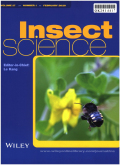- 钛学术文献服务平台 \
- 学术期刊 \
- 基础科学期刊 \
- 生物科学期刊 \
- 中国昆虫科学(英文版)期刊 \
null
Plasticity of mycangia in Xylosandrus ambrosia beetles
基本信息来源于合作网站,原文需代理用户跳转至来源网站获取
摘要:
Insects that depend on microbial mutualists evolved a variety of organs to transport the microsymbionts while dispersing.The ontogeny and variability of such organs is rarely studied,and the microsymbiont's effects on the animal tissue development remain unknown in most cases.Ambrosia beetles (Coleoptera:Curculionidae:Scolytinae or Platypodinae) and their mutualistic fungi are an ideal system to study the animalfungus interactions.While the interspecific diversity of their fungus transport organ—mycangia—is well-known,their developmental plasticity has been poorly described.To determine the ontogeny of the mycangium and the influence of the symbiotic fungus on the tissue development,we dissected by hand or scanned with micro-CT the mycangia in various developmental stages in five Xylosandrus ambrosia beetle species that possess a large,mesonotal mycangium:Xylosandrus amputatus,Xylosandrus compactus,Xylosandrus crassiusculus,Xylosandrus discolor,and Xylosandrus germanus.We processed 181 beetle samples from the United States and China.All five species displayed three stages of the mycangium development:(1) young teneral adults had an empty,deflated and cryptic mycangium without fungal mass;(2) in fully mature adults during dispersal,the promesonotal membrane was inflated,and most individuals developed a mycangium mostly filled with the symbiont,though size and symmetry varied;and (3) after successful establishrnent of their new galleries,most females discharged the bulk of the fungal inoculum and deflated the mycangium.Experimental aposymbiotic individuals demonstrated that the pronotal membrane invaginated independently of the presence of the fungus,but the fungus was required for inflation.Mycangia are more dynamic than previously thought,and their morphological changes correspond to the phases of the symbiosis.Importantly,studies of the fungal symbionts or plant pathogen transmission in ambrosia beetles need to consider which developmental stage to sample.We provide illustrations of the different stages,including microphotography of dissections and micro-CT scans.

推荐文章
期刊_丙丁烷TDLAS测量系统的吸收峰自动检测
带间级联激光器
调谐半导体激光吸收光谱
雾剂检漏 中红外吸收峰 洛伦兹光谱线型
不同盐度、温度及光照对漂浮浒苔生理生态的影响
浒苔
盐度
温度
光照
生理生态
期刊_联合空间信息的改进低秩稀疏矩阵分解的高光谱异常目标检测
高光谱图像
异常目标检测 低秩稀疏矩阵分解 稀疏矩阵 残差矩阵
内容分析
关键词云
关键词热度
相关文献总数
(/次)
(/年)
文献信息
| 篇名 | Plasticity of mycangia in Xylosandrus ambrosia beetles | ||
| 来源期刊 | 中国昆虫科学(英文版) | 学科 | |
| 关键词 | callow micro-CT mycangium symbiont-induced symbiosis teneral | ||
| 年,卷(期) | 2019,(4) | 所属期刊栏目 | |
| 研究方向 | 页码范围 | 732-742 | |
| 页数 | 11页 | 分类号 | |
| 字数 | 语种 | 英文 | |
| DOI | 10.1111/1744-7917.12590 | ||
五维指标
引文网络
引文网络
二级参考文献 (0)
共引文献 (0)
参考文献 (28)
节点文献
引证文献 (0)
同被引文献 (0)
二级引证文献 (0)
1963(2)
- 参考文献(2)
- 二级参考文献(0)
1973(1)
- 参考文献(1)
- 二级参考文献(0)
1985(1)
- 参考文献(1)
- 二级参考文献(0)
1992(1)
- 参考文献(1)
- 二级参考文献(0)
1995(1)
- 参考文献(1)
- 二级参考文献(0)
2003(1)
- 参考文献(1)
- 二级参考文献(0)
2004(1)
- 参考文献(1)
- 二级参考文献(0)
2007(2)
- 参考文献(2)
- 二级参考文献(0)
2008(1)
- 参考文献(1)
- 二级参考文献(0)
2009(1)
- 参考文献(1)
- 二级参考文献(0)
2010(1)
- 参考文献(1)
- 二级参考文献(0)
2011(3)
- 参考文献(3)
- 二级参考文献(0)
2013(1)
- 参考文献(1)
- 二级参考文献(0)
2014(2)
- 参考文献(2)
- 二级参考文献(0)
2015(4)
- 参考文献(4)
- 二级参考文献(0)
2017(5)
- 参考文献(5)
- 二级参考文献(0)
2019(0)
- 参考文献(0)
- 二级参考文献(0)
- 引证文献(0)
- 二级引证文献(0)
研究主题发展历程
节点文献
callow
micro-CT
mycangium
symbiont-induced
symbiosis
teneral
研究起点
研究来源
研究分支
研究去脉
引文网络交叉学科
相关学者/机构
期刊影响力
中国昆虫科学(英文版)
主办单位:
中国昆虫学会
中科院动物所
出版周期:
双月刊
ISSN:
1672-9609
CN:
11-3386/Q
开本:
出版地:
北京北辰西路1号院
邮发代号:
创刊时间:
语种:
eng
出版文献量(篇)
1404
总下载数(次)
0
总被引数(次)
4714
期刊文献
相关文献
推荐文献
- 期刊分类
- 期刊(年)
- 期刊(期)
- 期刊推荐
力学
化学
地球物理学
地质学
基础科学综合
大学学报
天文学
天文学、地球科学
数学
气象学
海洋学
物理学
生物学
生物科学
自然地理学和测绘学
自然科学总论
自然科学理论与方法
资源科学
非线性科学与系统科学
中国昆虫科学(英文版)2021
中国昆虫科学(英文版)2020
中国昆虫科学(英文版)2019
中国昆虫科学(英文版)2018
中国昆虫科学(英文版)2017
中国昆虫科学(英文版)2016
中国昆虫科学(英文版)2015
中国昆虫科学(英文版)2014
中国昆虫科学(英文版)2013
中国昆虫科学(英文版)2012
中国昆虫科学(英文版)2011
中国昆虫科学(英文版)2010
中国昆虫科学(英文版)2009
中国昆虫科学(英文版)2008
中国昆虫科学(英文版)2007
中国昆虫科学(英文版)2006
中国昆虫科学(英文版)2004
中国昆虫科学(英文版)2003
中国昆虫科学(英文版)2002
中国昆虫科学(英文版)2001
中国昆虫科学(英文版)2019年第6期
中国昆虫科学(英文版)2019年第5期
中国昆虫科学(英文版)2019年第4期
中国昆虫科学(英文版)2019年第3期
中国昆虫科学(英文版)2019年第2期
中国昆虫科学(英文版)2019年第1期

 免费查重
免费查重










